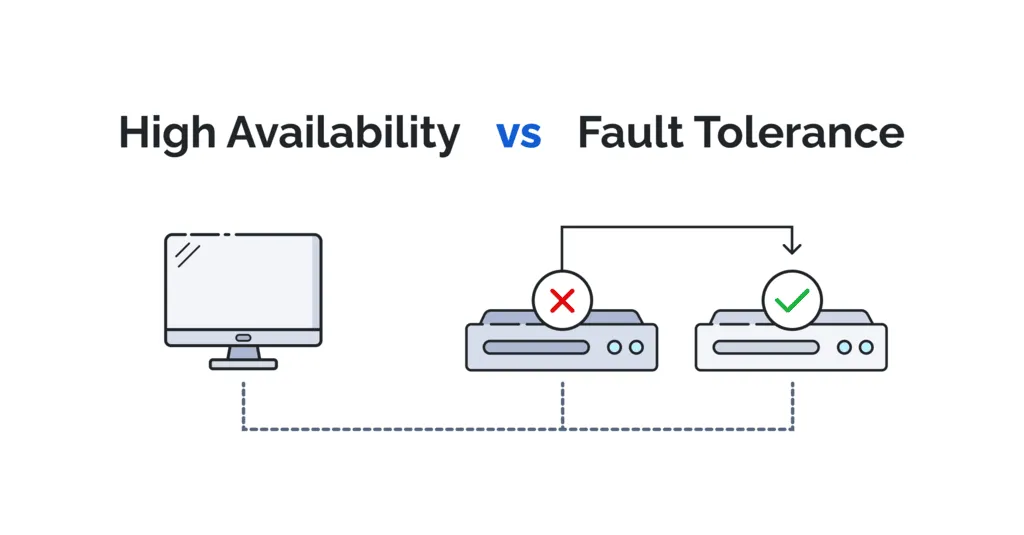Understanding High Availability vs Fault Tolerance in the Cloud
Introduction
Cloud computing has revolutionized how organizations design and manage IT infrastructure. Two critical concepts that ensure reliability and continuity are High Availability (HA) and Fault Tolerance (FT). While often used interchangeably, they serve distinct purposes and require different architectural approaches. This guide will help you understand their differences, implementation steps, usage examples, security best practices, and answer common questions.
Purpose of High Availability and Fault Tolerance
High Availability (HA)
- Minimizes downtime by quickly recovering from failures
- Ensures services remain accessible with minimal interruption
- Typically achieved through redundancy and failover mechanisms
Fault Tolerance (FT)
- Prevents service interruption even in the event of component failures
- Provides continuous operation by duplicating critical components
- Often involves real-time state replication and automatic failover
Prerequisites
- Basic understanding of cloud service models (IaaS, PaaS, SaaS)
- Familiarity with cloud providers (AWS, Azure, GCP)
- Knowledge of networking and distributed systems
- Access to a cloud account for hands-on implementation
High Availability vs Fault Tolerance: Feature Comparison
| Feature | High Availability | Fault Tolerance |
|---|---|---|
| Downtime | Minimal, but possible during failover | Zero (continuous operation) |
| Redundancy | Active-passive or active-active | Active-active (full duplication) |
| Cost | Lower (fewer resources duplicated) | Higher (full duplication of components) |
| Complexity | Moderate | High |
| Use Cases | Web servers, databases, APIs | Financial systems, healthcare, critical infrastructure |
Step-by-Step Guide: Implementing HA and FT in the Cloud
- Deploy application servers in multiple Availability Zones.
- Place servers behind an Elastic Load Balancer (ELB).
- Use Auto Scaling Groups to maintain desired capacity.
- Configure Amazon RDS Multi-AZ for database redundancy.
- Set up CloudWatch alarms for health monitoring and automated recovery.
- Deploy duplicate VMs in separate Fault Domains and Update Domains.
- Use Azure Load Balancer for traffic distribution.
- Implement Geo-redundant Storage (GRS) for data replication.
- Enable Automatic Failover for mission-critical databases.
- Test failover scenarios regularly to ensure seamless operation.
Usage Examples
- 1. Git Repository Hosting (GitHub, GitLab): Both platforms use HA clusters to ensure code repositories remain accessible even during server failures.
- 2. REST API Gateways: API gateways like AWS API Gateway or Azure API Management deploy across multiple zones for high availability.
- 3. Payment Processing Systems: Fault-tolerant architectures ensure zero downtime for critical financial transactions.
- 4. Kubernetes Clusters: Master nodes are replicated for HA, while worker nodes can be duplicated for FT in mission-critical workloads.
- 5. Cloud Storage Services (Amazon S3, Azure Blob): Data is replicated across regions for both HA and FT, ensuring durability and accessibility.
Sample Code: Configuring HA in AWS with Terraform
resource "aws_autoscaling_group" "example" {
name = "example-asg"
max_size = 3
min_size = 1
desired_capacity = 2
vpc_zone_identifier = ["subnet-123", "subnet-456"]
launch_configuration = aws_launch_configuration.example.id
health_check_type = "EC2"
health_check_grace_period = 300
}
Sample Code: Fault-Tolerant Storage in Azure
az storage account create \
--name mystorageaccount \
--resource-group myResourceGroup \
--location eastus \
--sku Standard_GRS \
--kind StorageV2
Security Best Practices
- Use least privilege principles for all cloud resources.
- Encrypt data at rest and in transit, especially across redundant nodes.
- Regularly patch and update all components in HA/FT setups.
- Implement multi-factor authentication (MFA) for administrative access.
- Monitor logs and set up alerts for suspicious activities.
FAQs
Conclusion
Understanding the distinction between high availability and fault tolerance is crucial for designing resilient cloud architectures. Choose the right approach based on your application's criticality, budget, and compliance requirements. For further reading, check the AWS High Availability & Fault Tolerance Whitepaper or the Azure Resiliency Documentation.
